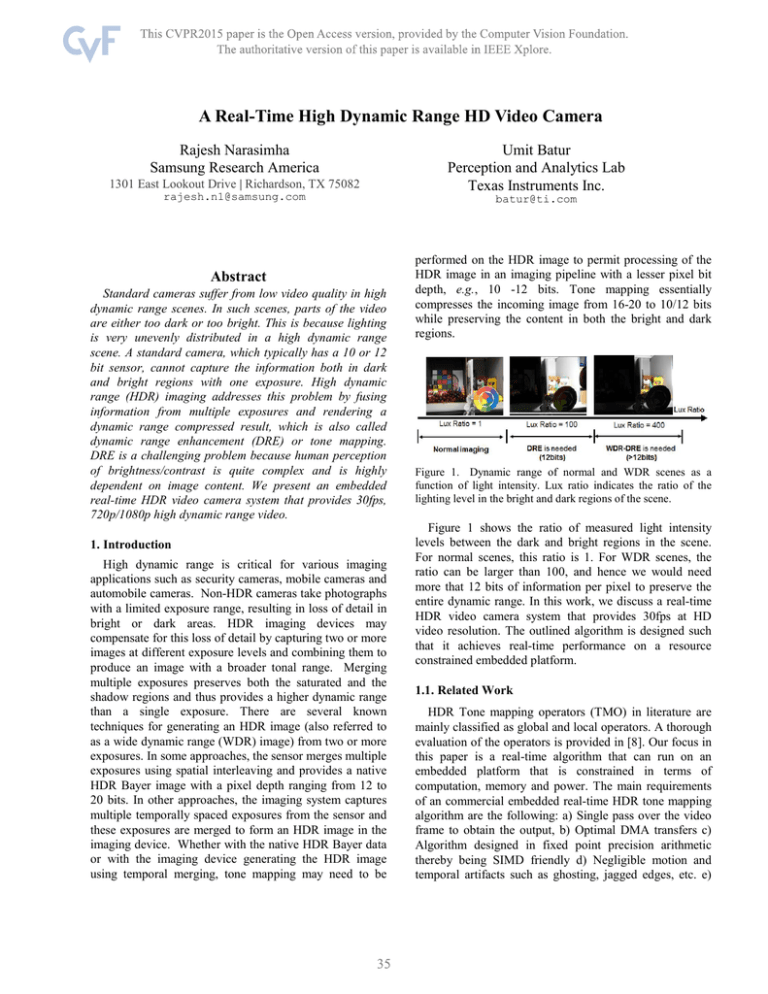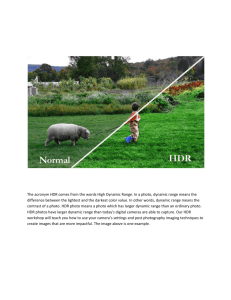A Real-Time High Dynamic Range HD Video Camera
advertisement

A Real-Time High Dynamic Range HD Video Camera
Rajesh Narasimha
Samsung Research America
Umit Batur
Perception and Analytics Lab
Texas Instruments Inc.
1301 East Lookout Drive | Richardson, TX 75082
rajesh.n1@samsung.com
batur@ti.com
performed on the HDR image to permit processing of the
HDR image in an imaging pipeline with a lesser pixel bit
depth, e.g., 10 -12 bits. Tone mapping essentially
compresses the incoming image from 16-20 to 10/12 bits
while preserving the content in both the bright and dark
regions.
Abstract
Standard cameras suffer from low video quality in high
dynamic range scenes. In such scenes, parts of the video
are either too dark or too bright. This is because lighting
is very unevenly distributed in a high dynamic range
scene. A standard camera, which typically has a 10 or 12
bit sensor, cannot capture the information both in dark
and bright regions with one exposure. High dynamic
range (HDR) imaging addresses this problem by fusing
information from multiple exposures and rendering a
dynamic range compressed result, which is also called
dynamic range enhancement (DRE) or tone mapping.
DRE is a challenging problem because human perception
of brightness/contrast is quite complex and is highly
dependent on image content. We present an embedded
real-time HDR video camera system that provides 30fps,
720p/1080p high dynamic range video.
Figure 1. Dynamic range of normal and WDR scenes as a
function of light intensity. Lux ratio indicates the ratio of the
lighting level in the bright and dark regions of the scene.
Figure 1 shows the ratio of measured light intensity
levels between the dark and bright regions in the scene.
For normal scenes, this ratio is 1. For WDR scenes, the
ratio can be larger than 100, and hence we would need
more that 12 bits of information per pixel to preserve the
entire dynamic range. In this work, we discuss a real-time
HDR video camera system that provides 30fps at HD
video resolution. The outlined algorithm is designed such
that it achieves real-time performance on a resource
constrained embedded platform.
1. Introduction
High dynamic range is critical for various imaging
applications such as security cameras, mobile cameras and
automobile cameras. Non-HDR cameras take photographs
with a limited exposure range, resulting in loss of detail in
bright or dark areas. HDR imaging devices may
compensate for this loss of detail by capturing two or more
images at different exposure levels and combining them to
produce an image with a broader tonal range. Merging
multiple exposures preserves both the saturated and the
shadow regions and thus provides a higher dynamic range
than a single exposure. There are several known
techniques for generating an HDR image (also referred to
as a wide dynamic range (WDR) image) from two or more
exposures. In some approaches, the sensor merges multiple
exposures using spatial interleaving and provides a native
HDR Bayer image with a pixel depth ranging from 12 to
20 bits. In other approaches, the imaging system captures
multiple temporally spaced exposures from the sensor and
these exposures are merged to form an HDR image in the
imaging device. Whether with the native HDR Bayer data
or with the imaging device generating the HDR image
using temporal merging, tone mapping may need to be
1.1. Related Work
HDR Tone mapping operators (TMO) in literature are
mainly classified as global and local operators. A thorough
evaluation of the operators is provided in [8]. Our focus in
this paper is a real-time algorithm that can run on an
embedded platform that is constrained in terms of
computation, memory and power. The main requirements
of an commercial embedded real-time HDR tone mapping
algorithm are the following: a) Single pass over the video
frame to obtain the output, b) Optimal DMA transfers c)
Algorithm designed in fixed point precision arithmetic
thereby being SIMD friendly d) Negligible motion and
temporal artifacts such as ghosting, jagged edges, etc. e)
1
Optimal color and contrast reproduction in the final HDR
tone-mapped frame and f) No halos in the bright/dark
boundaries. Based on the above stringent requirements, the
global operators described in literature can work in realtime systems, but they need manual parameter tuning,
while others are automatic [1][7] but cannot run in realtime since they are iterative (more than single pass on the
frame). To our knowledge, the local operators [2-5] are
hardware unfriendly since they are mostly iterative and
require significant hardware resources in terms of memory,
computation and power. A few of the operators that are
hardware friendly have been implemented on FPGAs
[6][9][16], on ARM SoC [17] and GPU [18].
Commercially available solutions include a hardware
accelerated software solution [10] and a FPGA based
solution [11] that provide good HDR image quality.
The solution we describe in the paper is a complete
software solution on a Texas Instruments Davinci media
processor [12-13] and achieves real-time performance on
high definition frame sizes (720p/1080p).
The paper is organized as follows. Section 2 provides
the overall HDR imaging pipe and explains the HDR tone
mapping in detail. Embedded implementation is explained
in section 3. Results and discussion is covered in section 4.
Conclusion and future work are in section 5.
a per-pixel basis to compensate for any decrease in
brightness.
The white balance block is configured to adjust the
white pixels in an HDR image to compensate for color
differences introduced by light sources, such as the
differences between incandescent, fluorescent, natural light
sources, XE strobe, and W-LED flash, as well as mixed
light conditions. This difference may result in a different
color appearance that may be seen, for example, as the
bluish appearance of a face or the reddish appearance of
the sky. Also, the sensitivity of each color channel varies
such that grey or neutral colors may not be represented
correctly. The 3A analysis block is configured to collect
metrics from the HDR image for auto focus, auto white
balance, and auto exposure of subsequent images. The
design of 3A for HDR data is an active research topic and
not the focus of this work. The tone mapping module is
configured to perform a method for local tone mapping on
the HDR image and will be explained in detail later. The
tone mapped image is provided to the remaining
components of the image pipeline for further processing to
generate the final HDR image, such as RGB blending,
gamma correction, conversion to the YCbCr color space,
edge enhancement, contrast enhancement, and/or false
chroma suppression.
2. Algorithm Description
Input images to the HDR pipeline (shown in Figure 2)
are Bayer pattern images. Thus each 2x2 pixels have four
color components – a red component denoted as R, a blue
component denoted as B, two green components denoted
as Gr and Gb. Here we assume that the 16-bit HDR image
is provided to us and do not focus on the temporal merging
of dual exposures. The defect correction component is
configured to correct the values of defective pixels in the
HDR image. As is well known, an image sensor may have
some number of defective pixels which respond to light
exposure differently than other pixels due to factors such
as manufacturing faults. This correction is performed using
a look-up table (LUT) based technique. The defect
corrected image is provided to the black level adjustment
block. The black level adjustment block is configured to
set sensor black to image black in the HDR image. That is
needed because image sensors may record some non-zero
value at dark pixel locations. The adjusted HDR image is
provided to the noise filter component to remove various
sources of noise in an HDR image by averaging similar
neighboring pixels. The filtered HDR image is provided to
the lens shading correction component. Lens shading is the
phenomenon that an image is bright in the center and
decreases in brightness towards the edges of the image.
Lens shading correction is performed by a gain applied on
Figure 2. HDR Pipeline
Figure 3. HDR Tone-Mapping Algorithm
2
interpolation which results in a 5-point tone curve. Thus
for the simple case, the three points of the local tone curve
in the [x,y] format are [0 0], [CB TB] and [255, 255] as in
the right plot of Figure 5.The 256 points on the tone curve
are constructed from these three points using band limited
interpolation and Hermite polynomials [19]. The left plot
in Figure 5 illustrates the determination of the value of the
delta_brightness to be added to the block mean pixel value
to determine the target brightness TB. In this graph, the x
-axis is the block mean value scaled from 16 bits to 8 bits
and the y-axis is delta_brightness (gain). As seen from this
graph, for scaled block mean pixel values less than the first
knee point k1, the delta_brightness is the value of gain1.
For scaled block mean pixel values larger than the second
knee point k2, the delta_brightness is the value of gain2.
For scaled block mean pixel values between the two knee
points, the value of delta-brightness is chosen along the
gain curve between the two knee points. The determination
of delta_brightness values for particular block mean pixel
values may be implemented as a lookup table (LUT) of
255 values derived based on the values of k1, k2, gain1, and
gain2. The knee points and the gains may have any
suitable values, are chosen based on quality preference.
2.1. HDR Tone-Mapping
The HDR tone-mapping algorithm is shown in Figure 3.
The luminance image is computed from the input Bayer
frame. For example, if the size of the Bayer is 1280x736
(720p), the size of the luminance image is 640x368. This
is down-sampled to 320x184 to achieve speedup. We will
discuss the embedded implementation in the next section.
White point adjustment is then performed on the
luminance image and is important due to the wide dynamic
range. For example, for 16-bit pixel depth, the dynamic
range is [0- 65535] where black is represented 0 and white
as 65535. If the values of the white pixels in the image are
not close to true white, i.e., 65535, low contrast may result
in the tone-mapped image. The white point adjustment can
be performed as follows. First, a histogram of the pixel
values in the image is computed and the whitest pixel
value, e.g., 65500, in the image is determined from the
histogram. A small percentage of the white pixels with
values closest to the whitest pixel value, e.g., 2-5%, are
then saturated to white, i.e., the values of these pixels are
changed to 65535. Further, after the saturation process,
every pixel in the image is scaled by the gain between the
whitest original pixel value and true white.
The
percentage of the whitest pixels to be saturated is an
implementation choice.
2.1.1
2.1.2
Gain Map Computation
After the local tone curves are constructed for each
block, a gain map is computed using the local tone curves
and weighted using bilateral interpolation for each pixel
since the local tone curves are at the block centers. We
chose to calculate the local tone curves for 209 (19
horizontal and 11 vertical) blocks. The resulting gain map
contains a gain corresponding to each pixel in the
luminance image. The gain G(x,y) for a 16-bit luminance
pixel X(x,y) in the luminance image with the value L is
computed as
G ( x, y ) Lout / L
(1)
Tone Curve Generation
The luminance image is then divided into overlapping
blocks and a block mean pixel value is computed for each
of the blocks. The block size and the amount of overlap
between the blocks is implementation dependent and may
be chosen empirically, for example, based on a tradeoff
between quality and performance. The block mean pixel
value may be computed in any suitable way, e.g., as the
average of the pixel values in the block or as a weighted
average of the pixel values in the block. If a weighted
average is used, the weight for each pixel may be based on
the inverse of pixel intensity difference between the center
pixel of the block and the pixel. Local tone curves are then
computed for each block. These tone curves may be of
any suitable length. For simplicity of explanation, the
length of each local tone curve is assumed to be 256.The
computation of a local tone curve of length 256 is
illustrated in Figure 5.
To compute a tone curve for a block, three points on the
curve are determined as illustrated in Figure 5B. In this
figure, CB is the block mean value, TB = CB +
delta_brightness is the target brightness, and LC and RC
are, respectively, left and right contrast (i.e., the midpoint
between 0 and CB and the midpoint between CB and 255,
respectively). The three points of a tone curve for the
simple case, LC =0 and RC=255 or these can be estimated
based on CB and computing the gain values using hermite
where Lout is computed as a weighted sum of applying the
tone curves of the four neighboring blocks having center
points closest to X(x,y) compared to L. The four block
centers closest to X(x,y) are referred to as the upper-left
(UL) point, the upper-right (UR) point, the lower-left (LL)
point, and the lower-right (LR) point. Figure 4 is an
example illustrating the locations of the center points
relative to X(x,y). Each of the small circles in the images
is a center point of a block. For odd block sizes, the center
point is the center pixel in the block. We provide
embedded friendly fixed-point implementation equations
below. For even block sizes, the center point is between
the four center pixels in the block. More specifically, Lout
is computed as follows,
UR UR
LR LR
(2)
Lout UL LUL
Lout LL LLL
Lout
out
out
3
intensity weight (gain). As in the earlier case for
delta_brightness computation, for values of |L-LNN| less
than the first knee point k1, the intensity weight is the value
of gain1. For values of |L-LNN| larger than the second knee
point k2, the intensity weight is the value of gain2. For
values of |L-LNN| between the two knee points, the
intensity weight is chosen along the gain curve between the
two knee points. The determination of intensity weights
for particular values of |L-LNN| may be implemented as a
lookup table (LUT) of size 255 values derived based on
the values of k1, k2, gain1, and gain2. The knee points and
the gains may have any suitable values, which may be
selected empirically. In our case, the values of the knee
points and the gains are the same as those used to generate
the LUT for determining the value of delta_brightness for
particular block mean pixel values. Since it is lot of
computation overhead to deal with 16-bit pixel values, we
use LUT to map them to a smaller range for
delta_brightness and iwNN computations.
where NN = {UL, UR, LL, LR} and LNN
out is the result of
applying the tone curve of the block containing the nearest
neighbors (NN) with respect to the center point of X(x,y)
and NN is a weight computed for this result, The value of
LNN
out is computed as,
LNN
out
LUT [ L floor ] NN Wceil LUT [ Lceil ] NN W floor
Wceil W floor
(3)
where LUT[] NN is the tone mapping lookup table for the
floor and ceil luminance values for set NN from the current
center point of X(x,y) and L floor , Lceil , W floor , and Wceil are
computed as follows. The floor and ceiling values of L are
computed as per
L
;0 L floor 254
256
L floor 1;1 L floor 255
L floor
Lceil
(4)
and the floor and ceiling weights are computed as per
W floor L L floor * 256
.
(5)
Wceil Lceil * 256 L
The value of
in equation (2) is computed as follows,
NN
NN
NN dw
iwNN ;0 dw
, iwNN 1
(6)
NN
dw
where
is a distance weight based on the distance
from the NN pixels with respect to the center point X(x,y)
and iwNN is an intensity weight based on the difference in
intensity between the mean pixel value of the block
containing the NN neighboring center point and current
block mean L. This is depicted in Figure 6. Assuming that
that the block size is odd and the center point is the center
NN
pixel of the block, the distance weight dw
is computed as
Figure 4. An example illustrating local tone mapping
follows,
NN
dw
x x NN y y NN /
(7)
where (xNN, yNN) are the coordinates of the NN with respect
to the center point coordinates (x,y) and λ is a
normalization factor to scale the distance weight to be
between 0 and 1 inclusive. If the block size is even, the
center point is located between the four center pixels of the
block, and the distance weight is computed based on the
distances from the pixel X(x,y) to each of these four center
pixels. The intensity weight iwNN is computed as per
NN
iw
LUT L L NN
(A)
(B)
Figure 5. Graphs illustrating generation of local tone curves
Referring again to Figure 3, once the gain map is
computed, the gains are applied to the four Bayer channels
of the HDR image. To apply the gains, the gain map is upsampled to the original HDR frame resolution and the
gains applied to the four Bayer components of the
corresponding pixels in the HDR image. The gains may be
applied as per
Rbayer(x,y) = G(x,y) Rbayer(x,y)
Grbayer(x,y) = G(x,y) Grbayer(x,y),
(9)
(8)
where LNN is the mean pixel value of the block containing
the NN neighboring center point and the LUT is derived as
per the graph similar to the left plot in Figure 5.
Figure 6 are examples illustrating, respectively, the
computation of the distance weights and the intensity
weights for X(x,y). Similar to the left plot in Figure 5, the
x axis for iwNN computation is |L-LNN| and the y-axis is the
4
Gbbayer(x,y) = G(x,y) Gbbayer(x,y)
Bbayer(x,y) = G(x,y) Bbayer(x,y).
We make sure that the final Bayer values are in the 16bit range using scaling if needed. While up sampling,
directional filtering is used to eliminate any artifacts that
may arise.
were eliminated using directional filtering after the gain
map was up sampled and applied to the Bayer image.
5. Conclusion and Future Work
An embedded real-time HDR video camera solution is
discussed. The fixed point solution achieves 30fps at high
definition video resolutions (720p/1080p) without
compromising on quality. The solution was evaluated
using perceptual tests and against commercially available
embedded solutions.
3. Embedded Implementation
The flow diagram for the embedded implementation is
shown in Figure 7. The HDR sensor delivers a 12-bit
compressed data. The frames are first de-compressed into
16/20-bit, and then a scene adaptive local dynamic range
enhancement algorithm explained earlier is applied to
convert this HDR data into 12-bit Bayer frames. These
frames are processed by a hardware image pipeline (ISP)
to produce YCbCr 4:2:0 video frames, which are then
encoded into H.264.
References
[1] E. Reinhard, G. Ward, P. Debevec, P. Sumanta, W.
Heidrich,and K. Myszkowski, “Parameter estimation for
photographics tone reproduction.,” Journal of Graphics
Tools, vol. 7(1), pp. 45-51, 2003
[2] F. Durand and J. Dorsey, “Fast bilateral filtering for the
display of high-dynamic-range images.,” ACM Transactions
on Graphics, vol. 21(3), pp. 257–266, 2002.
[3] R. Fattal, D. Lischinski, and M. Werman, “Gradient domain
high dynamic range compression.,” ACM Transactions on
Graphics, vol. 21(3), pp. 249–256, 2002.
[4] Y. Li, L. Sharan, and E. Adelson, “Compressing and
companding high dynamic range images with subband
architectures.,” ACM Transactions on Graphics, vol. 24(3),
pp. 836–844, 2005.
[5] R. Mantiuk, S. Daly, and L. Kerofsky, “Display adaptive
tone mapping.,”ACM Transactions on Graphics, vol. 27(3),
pp. 68, 2008.
[6] F. Hassan and J. Carletta, “An fpga-based architecture for a
local tone-mapping operator.,” Real-Time Image
Processing, vol. 2, pp. 293–308, 2007.
[7] G. Ward, H. Rushmeier, and C. Piatko, “A visibility
matching tone reproduction operator for high dynamic
range scenes.,” IEEE Transactions on Visualization and
Computer Graphics, vol. 3(4), pp. 291–306, 1997.
[8] P. Ledda, A. Chalmers, T Troscianko, and H. Seetzen,
“Evaluation of tone mapping operators using a high
dynamic range display.,”ACM Transactions on Graphics,
vol. 24(3), pp. 640–648, 2005
[9] Chris Kiser, Erik Reinhard, Mike Tocci and Nora Tocci,
"Real-time Automated Tone Mapping System for HDR
Video.", IEEE International Conference on Image
Processing, 2012
[10] www.apical.co.uk/products/iridix-hdr/
[11] http://www.axis.com/files/whitepaper/wp_wide_dynamic_ra
nge_49148_en_1210_lo.pdf
[12] http://www.ti.com/tool/dm368ipnc-mt5
[13] http://www.ti.com/tool/dm385-ar0331
[14] http://www.aptina.com/products/image_sensors/mt9m034/
[15] http://www.aptina.com/products/image_sensors/ar0331/
[16] Pierre-Jean Lapray, Barthélémy Heyrman, Matthieu Rossé,
and Dominique Ginhac, "Smart camera design for realtime
high dynamic range imaging.," ICDSC, page 1-7, 2011
[17] Ching-Te Chiu, Tsun-Hsien Wang, Wei-Ming Ke, Chen-Yu
Chuang, Jhih-Siao Huang, Wei-Su Wong, Ren-Song Tsay,
Cyuan-Jhe Wu, "Real-Time Tone-Mapping Processor with
Integrated Photographic and Gradient Compression using
Figure 6. Computation of distance weights and pixel intensity
weights for local tone mapping
Figure 7. HDR tone-mapping frontend
4. Results and Discussion
Figure 8 depicts the HDR results for various challenging
scenes which are actual screen shots from the real-time
implementation. The left column image is one without the
HDR algorithm and the right column image is with the
algorithm. We provide a HDR light-box scene, a lab scene,
a light scene and a outdoor scene. The left column image is
the original 16-bit HDR image converted to a 12-bit image
without tone mapping and the right column image is the
12-bit HDR image with local tone mapping applied. Note
the improvement in brightness and contrast after the local
tone mapping is applied. In figure 9, we provide some
examples of the common issues with HDR scenes namely,
halo artifacts around bright/dark boundary and jagged
edges due to fixed point arithmetic on embedded
platforms. The halo artifact was solved by using down
sampling luminance (Y plane in YUV422 frame) using
pixel-shift rather than averaging and implementing both
distance and intensity based weighting for bilinear
interpolation. The jagged edges shown by the “arrows”
5
0.13 μm Technology on an Arm Soc Platform.,"" Signal
Processing Systems vol. 64(1), pp. 93-107, 2011
[18] Ahmet Oğuz Akyüz, "High Dynamic Range Imaging
Pipeline on the GPU.," Springer Journal of Real-Time
Image Processing
[19] http://en.wikipedia.org/wiki/Hermite_polynomials
Figure 8. HDR results for HDR light-box scene, a lab scene, a light scene and an outdoor scene. The left column images are the original
16-bit HDR image converted to a 12-bit image without tone mapping and the right column images are the 12-bit image HDR image with
local tone mapping applied.
6
Figure 9. Halo artifacts around bright/dark boundary and jagged edges due to fixed point arithmetic on embedded platforms
denoted by arrows in the left column images. The issues are resolved in the right column images.
7
225


